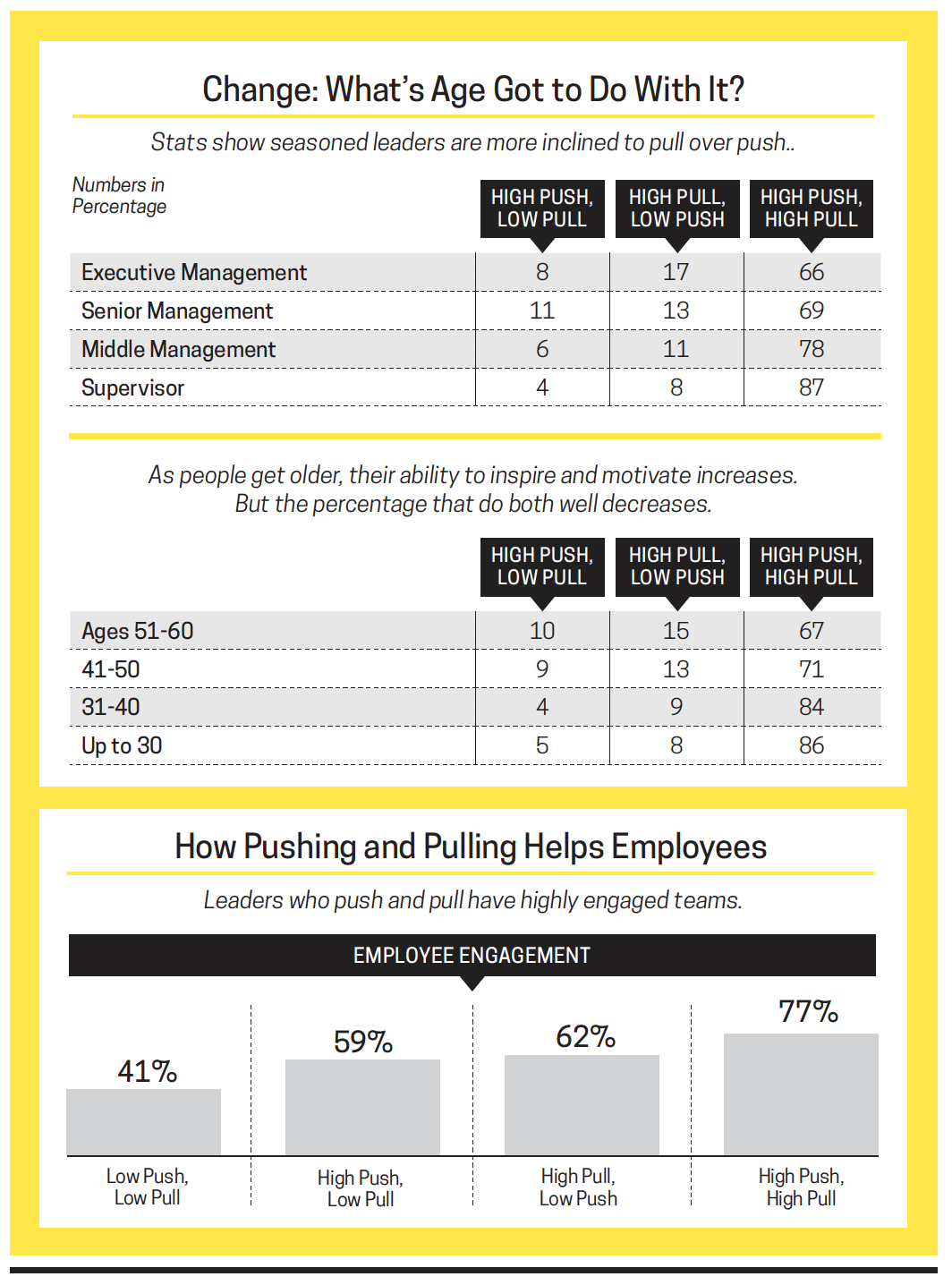They’re skilled in both pushing and pulling. Here’s how to adopt each approach.
By Jack Zenger and Joe Folkman
What’s the difference between leadership and management? This isn’t a set up to a lame joke you’d tell at the office holiday party, but rather, a serious question that management scholars first attempted to answer decades ago—and are arguably still trying to crack.
Back then, experts proposed that management was largely meant to make an organization function well; it was about helping the flywheel of the firm turn smoothly while generally maintaining the status quo. Predictability and stability were given precedence.
Leadership, on the other hand, was characterized as being about moving to a higher level, or identifying a new direction. It wasn’t about merely maintaining the status quo; it was about change. While scholars have since made other distinctions, like how management is about things and leadership about people, the litmus test of “change” seemed the most useful and understandable in distinguishing leadership and separating the two concepts.
Few people today would question the importance of a leader’s ability to bring about change. After studying a group of nearly 90,000 leaders, we discovered that a leader’s ability to lead change is extremely correlated with his or her perceived overall effectiveness.
Yet despite our hard data—and the wealth of literature on the topic of change—there doesn’t appear to be much consensus on how leaders actually bring about change. Many change models have been proposed that define a process to follow, but provide far less on the methods. Our view is the methods that have been identified can be put into two distinct categories: push and pull.
The Push Approach
Leaders decide on a target, figuratively put their hands on their colleagues’ backs, and push. They set stretch goals that go beyond where people would otherwise have thought possible. They initiate new procedures. They hold their colleagues accountable with incentives and exert discipline on their people to make things happen.
The Pull Approach
This approach begins when leaders articulate a vivid picture of what they envision for the future. With that vision in mind, they use it as a “north” and employ a variety of tools to get their col-leagues to adopt it as their goal; lift their aspirations to achieve that target; and through positive reinforcement, work to have the organization make the changes necessary to accomplish that goal.
We can all think of leaders who fit into one of the two camps. But according to our data—collected through 360-degree feedback on more than 87,000 leaders—we place four out of five leaders in the push camp. Indeed, much of the literature in management dating back a few decades would emphasize push. Managers who could “control” an operation were more likely to be perceived as “good” managers.
Historically, three out of four leaders who rated highly (in the top 10 percent) on their ability to bring about change were thought to be on the push side of the equation. Only one in four scored higher on pull than on push.

The Importance of “And”
As often happens when you compare two different patterns of behavior, you begin to see that the ideal place isn’t necessarily on the side of one versus the other, but a combination of the two.
Here’s an example: An executive was appointed to head up a major division of a company. He concluded that several changes were needed, including a new organization structure, a new go-to market strategy, and new elements for improving the customer experience. The group he inherited had been doing things the same way for a decade.
The executive began by discussing the need for change with the team. He gradually introduced a new vision, but solicited his team’s views and gave them a full hearing. Before long, the executive’s vision took shape and became clearer as he interacted with his team.
All but two employees were supportive of the new direction, but the new executive still listened carefully to their reservations. Initially, he pulled.
Then the executive told the group that the decision had been thoroughly discussed, and their objections had been heard, but they all needed to get on board. Ultimately, one outlying employee stayed with the organization, while the other left. In this case, pull clearly had moved to push—an example of how the best leaders follow both approaches.
In one study, we analyzed leaders who were in the top quartile on their ability to push or pull, versus those who were below the top quartile—labeled “low” in the chart above.
The takeaway: Being effective at either approach doubles your ability to bring about change. Leaders who are in the top 10 percent on their ability to lead change have an average effectiveness score on pull at the 89th percentile, while their push scores are slightly less positive, at the 87th percentile. As people shift in their ability to lead change, their pull exceeds their push.

The Impact of Position and Age
The good news: Leaders at higher levels on the corporate ladder are more inclined to pull over push. On the flip side, the likelihood for a leader to use both push and pull decreases at higher management levels. Do they become accustomed to utilizing one method? Do they succumb to the twin demons of arrogance and complacency? Do they become less involved in change efforts as they move up?
It’s remarkable how similar the two charts above are in terms of the approach being used. There’s an obvious correlation between organizational level and age. The psychologist Abraham Maslow was fond of describing this in his famous hammer analogy: “If all you have is a hammer, everything looks like a nail.” To put it in our terms, if all you know how to do is push, then for every problem the best solution is to push.
We’ve found that leaders can more effectively bring about change if their direct reports are engaged. But when a team has low levels of engagement, they generally resist change. In one study, we looked at 76,000 teams along with the effectiveness of the team leaders who were judged on both push and pull dimensions, as rated by their direct reports. We also measured the engagement levels of those direct reports. Once again, it’s clear to see the impact of leaders being skilled at both push and pull because their team engagement is above the top quartile.
Effective change leaders begin by describing the proposed change to others and asking them their opinions, which pulls people toward the change.
After these discussions, leaders may start to create a plan for change and set goals and deadlines. They may assign specific tasks to others and hold them accountable for achieving those objectives on time and on budget. While this is more of a push activity, using both approaches will enable change efforts to be more successful.
The bottom line: If you’re energized and inspired about a change, your team will join you—one way or another.
Jack Zenger is the co-founder and CEO of Zenger Folkman, a professional ser-vices firm providing consulting and leadership development programs for organizational effectiveness initiatives. He is the co-author of seven books on leadership, including Speed—How Leaders Accelerate Successful Execution.
Joe Folkman is the co-founder and president of Zenger Folkman. He is a highly acclaimed keynote speaker at conferences and seminars the world over. His expertise focuses on a variety of subjects related to leadership, feedback, and individual and organizational change.


